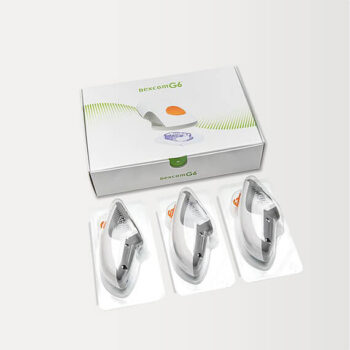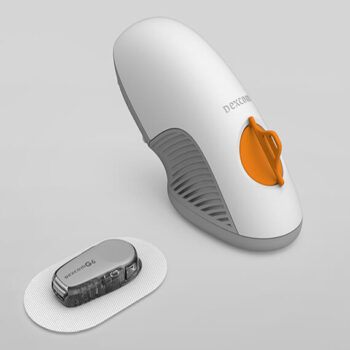Table of content
Introduction
The Dexcom G6 Continuous Glucose Monitoring (CGM) system has revolutionized diabetes management, offering an accurate and real-time view of glucose levels. To maintain its effectiveness, regular sensor replacement is significantly important.
In this comprehensive guide, we’ll walk you through the step-by-step Dexcom G6 sensor replacement process. In this way, we ensure seamless glucose monitoring and better diabetes control.
Let’s Get Started
Understanding Dexcom G6 CGM
Before we dive into the replacement process, let’s take a moment to understand how the Dexcom G6 CGM system works. This innovative technology consists of three main components:
Sensor: The small, discreet sensor is applied to your skin and continuously measures your glucose levels.
Transmitter: The transmitter securely attaches to the sensor and wirelessly sends real-time glucose data to the receiver or compatible smart devices.
Receiver/Smart Device: The receiver or smart device displays your glucose data, providing you with insights to make informed decisions about your diabetes management.
When does the Dexcom G6 sensor replacement is needed?
The Dexcom G6 sensor is designed to function for ten days. After this period, it is essential to replace the sensor to ensure accurate glucose readings. Attempting to use the sensor beyond ten days may result in less reliable data and potential discomfort.
It’s important to note that the sensor may also need replacement if it becomes loose, damaged, or dislodged before the ten-day mark.
How to replace the Dexcom G6 sensor?
Replacing the Dexcom G6 sensor is not a difficult task to perform. If you follow the appropriate steps, you can easily remove the old sensor and insert the new one. The following are some essential steps that you must not forget while replacing the Dexcom G6 sensor:
Gathering the necessary supplies
Before you begin the sensor replacement process, gather all the necessary supplies. Here’s what you’ll need:
- A new Dexcom G6 sensor
- An alcohol swab or alcohol wipes
- Skin barrier wipes or adhesive wipes (optional but recommended for better adhesion)
- A sensor applicator (usually provided in the G6 CGM system package)
- A compatible receiver or smart device with the Dexcom G6 app installed
Ensure all your supplies are within reach to avoid interruptions during the replacement process.
Preparing for sensor replacement
Before starting the sensor replacement, wash your hands thoroughly with soap and water. It’s highly recommended to maintain clean hands throughout the process to prevent contamination. Once your hands are clean and dry, gather your supplies and sit in a well-lit, comfortable area.
Removing the old sensor
Now that you’re prepared for the sensor replacement, it’s time to remove the old sensor.
Locate the old sensor: Gently lift any adhesive covering or tape around the sensor to expose it.
Detach the transmitter: Carefully detach the transmitter from the old sensor. To do this, hold the transmitter firmly and peel it away from the sensor site. Be cautious not to damage the transmitter, as it is reusable.
Remove the sensor from your skin: Slowly peel off the old sensor from your skin, using a gentle motion to avoid skin irritation.
Clean the area: Use an alcohol swab or alcohol wipe to clean the skin around the sensor site thoroughly. Ensure the area is dry before proceeding to the next step.
Preparing the new sensor
With the old sensor removed, let’s prepare the new sensor for insertion.
Unpack the new sensor: Take the new Dexcom G6 sensor out of its packaging. Ensure that the packaging is intact and that the sensor is not expired.
Warm up the sensor: To ensure accurate readings, warm up the sensor before insertion. Place the sensor in your hand or under your arm for about 20 to 30 minutes. This step is crucial as it helps the sensor acclimate to your body temperature, resulting in more accurate glucose readings.
Inserting the new sensor
Now that the new sensor is prepped and ready, it’s time to insert it.
Choose a new site: Select a new sensor site on your body. Common locations include the abdomen, upper buttocks, or upper thighs. Avoid areas with scars, moles, or any skin irregularities.
Clean well: Clean the chosen site with an alcohol swab or alcohol wipe. Allow the area to dry completely before proceeding.
Insert the sensor: Use the sensor applicator provided in the Dexcom G6 CGM system package. Remove the applicator’s protective cap and gently press the adhesive side of the sensor onto the cleaned site. Ensure the sensor is securely in place.
Attach the transmitter: Carefully attach the transmitter to the sensor site. It should fit snugly and securely on top of the sensor.
Initiating the Sensor Warm-up
Now that the new sensor is in place and the transmitter is attached, it’s time to initiate the warm-up process.
Start the Warm-up on Your Receiver/Smart Device: If you’re using a receiver or smart device, navigate to the settings or sensor menu and start the warm-up process. The Dexcom G6 system usually requires a two-hour warm-up period before providing accurate glucose readings.
Stay Patient during Warm-up: During the warm-up period, be patient and avoid making any significant diabetes management decisions based on the initial readings. The warm-up period allows the sensor to calibrate and provide reliable data.
Verifying Sensor Accuracy
After the warm-up period is complete, it’s time to verify the sensor’s accuracy.
Check Your Glucose Levels: Once the warm-up period is over, check your glucose levels on your receiver or smart device. Compare the readings with how you feel to ensure they align with your current condition.
Calibrate if Necessary: If the sensor’s readings seem inaccurate or differ significantly from how you feel, you may need to calibrate the Dexcom G6 system. Follow the calibration instructions provided by Dexcom to fine-tune the accuracy.
Buy from us!
If you are thinking about a Dexcom G6 sensor replacement, you may need to buy it first. For this purpose, you will have to look for a reliable platform that provides you with an original device at market competitive rates. For this purpose, you can rely on CGM Monitors. We are included as the most reputable Dexcom G6 supplier all over the USA.
We make your replacing Dexcom G6 sensor highly comfortable for you by offering monthly refills. If you are planning to move to some other CGM device, you can also buy Dexcom G7 and other better CGM devices from us.
Conclusion
Effortless Dexcom G6 sensor replacement is a matter of great importance for maintaining accurate glucose readings and effectively managing your diabetes. By following our step-by-step guide, you can confidently navigate the sensor replacement process, ensuring a seamless experience with your CGM system.
Remember, consistent sensor replacement every ten days, proper site preparation, and calibration, if necessary, are essential for getting the most out of your Dexcom G6 CGM system. With accurate glucose data at your fingertips, you can make informed decisions to lead a healthier and happier life with diabetes. Always consult your healthcare provider for personalized guidance and support along your diabetes management journey.
Frequently Asked Questions
What is the Dexcom G6 Continuous Glucose Monitoring (CGM) system?
The Dexcom G6 CGM system is a technology that continuously measures glucose levels using a discreet sensor applied to the skin. It wirelessly sends real-time glucose data to a receiver or compatible smart devices for better diabetes management.
When is Dexcom G6 sensor replacement needed?
The Dexcom G6 sensor needs replacement after ten days of use to ensure accurate glucose readings. If it becomes loose, damaged, or dislodged before the ten-day mark, it may also require replacement.
How do I replace the Dexcom G6 sensor?
To replace the Dexcom G6 sensor, follow these steps:
- Gather necessary supplies: new sensor, alcohol swab, applicator, and receiver/smart device.
- Prepare: Wash hands, sit in a well-lit area, and gather supplies.
- Remove old sensor: Detach transmitter, peel off old sensor, and clean the area.
- Prepare new sensor: Unpack, warm up, and choose new insertion site.
- Insert new sensor: clean site, use applicator to place sensor, and attach transmitter.
- Initiate warm-up: Start on receiver/smart device and wait two hours.
- Verify accuracy: Check glucose levels, compare them with how you feel, and calibrate if needed.
Where can I buy a Dexcom G6 sensor?
You can buy Dexcom G6 sensors, as well as other CGM systems, from CGM Monitors, a reputable supplier offering original devices at competitive rates with monthly refills.
Why is consistent sensor replacement important?
Consistent sensor replacement every ten days is crucial for maintaining accurate glucose readings and effectively managing diabetes. It ensures reliable data for informed decisions and better health outcomes. Always consult your healthcare provider for personalized guidance and support in your diabetes management journey.











Write a comment
Your email address will not be published. All fields are required